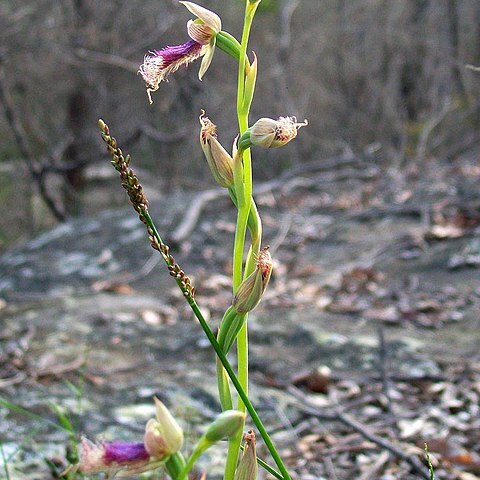Leaf fully developed at flowering, 150–400 × 8–14 mm, dark green, base red. Flower stem 150–300 mm tall, 1–9-flowered. Flowers lasting 3–5 days, 30–35 × 15–25 mm; sepals and petals green to brown, strongly marked with red stripes; labellum usually with red and purple papillae, occasionally mauve, bronze, greenish or whitish. Dorsal sepal incurved to spreading, ovate, 12–15 × 8–9 mm, apex bluntly apiculate. Lateral sepals widely divergent, narrowly deltate, 12–15 × 4–5 mm, tapered from below middle to acuminate apex. Petals incurved to spreading, 7–8 × 4–5 mm, apex hooked. Labellum flat in profile, 25–30 × 12–16 mm, transversely elliptical in basal third then suddenly contracted inwards and tapered evenly to apex, ending in a short glandular tail; basal part with crowded, short, dark purple papillae; central part with longer, coarse, horn-like, eglandular and glandular papillae (often curved) to 6 mm long; apical part with a glandular tail 3–6 × 1 mm; labellum margins with numerous slender, pointed lobes to 7 mm long, glandular lobes only in distal two-thirds. Column 5–6 × 3–3.5 mm, pale green, with 2 purple sham eyes connected by a prominent ridge.
More
A stout fleshy orchid. It keeps growing from year to year but dies back in winter. It grows 35 cm high and spreads 15 cm wide. The stem is thick. The leaf near the base is ribbed. It clasps the stem. There are bracts on the stem. The flowering stem is 25-45 cm high. There are 4-6 flowers. They are green with purple stripes. The labellum is reddish purple and bearded.
Plant slender to robust, perhaps not reaching such lengths as C. paludosus, but lf us. broader. Bracts, racemes, sepals and petals much as in C. paludosus. Labellum c. 2 × sepals; ligulate apex short, ± twisted; disc broad with long dense processes; base covered with short rounded calli. Column-wings each with one well-defined, us. dark gland or callus near base.
Widespread and common from coast to mountains; growing in a range of habitats including heath, heathy forest, open forest, woodland and tall, moist to wet forest in freely draining to moisture-retentive sand, laterite, clay loam and well-structured mountain loam; plants are also occasionally found on the margins of swamps in peaty soil.
More
It is a temperate plant. It grows in heaths and scrub and open Eucalypt forest. It grows on well drained soil and rocky ground. It does best in light humus-rich soil in a protected shady position. It is sensitive to drought and tender to frost.

